Vercel vs Railway
You've heard of both platforms, Vercel and Railway, and now you need to choose one for your next project. Vercel dominates the Next.js ecosystem with its global edge network, while Railway offers Docker-based deployments with integrated databases and persistent containers.
Both platforms deploy web applications, but they're built for different use cases. Understanding these differences will save you from architectural headaches and surprise costs.
This guide compares architecture, pricing, developer experience, performance, security, and migration to help you choose the platform that best fits your project.
Quick Decision Framework
Vercel and Railway solve different problems. Vercel optimizes for frontend deployments with serverless APIs, while Railway handles full-stack applications that need persistent processes. Here's how to choose which service to use in case you want to deploy an application:
Choose Vercel If
-
You're building a frontend-focused app (Next.js, React, static sites).
-
You need a global CDN and edge distribution.
-
Your app doesn't require WebSockets or real-time features.
-
You're comfortable with external database services (Supabase, PlanetScale).
-
You want zero infrastructure decisions: Vercel handles everything automatically.
Choose Railway If
- You're building a full-stack application that needs persistent connections, background workers, or continuous processes.
- You're running background jobs, cron tasks, or data processing that takes longer than 13 minutes.
- You want your database, backend, and workers in one place without juggling multiple services.
- You need scaling headroom (up to 8 vCPU / 8 GB RAM on Hobby, 32 vCPU / 32 GB on Pro).
How We're Making This Comparison
We deployed the same Express + Tailwind CSS + Postgres application to both platforms to show you exactly what the setup process looks like and where the platforms diverge. The technology stack represents a typical full-stack app without framework-specific optimizations that would favor one platform over the other.
The architectural differences you'll see here apply whether you're building with Express, Django, Rails, or any backend framework.
Architecture
The core difference between Vercel and Railway is in how they run your application. Knowing their architecture determines what types of applications you can actually build.
Vercel: Serverless Functions
Vercel routes each API request to a serverless function that spins up, executes your code, and shuts down. Their Fluid Compute model runs multiple invocations on a single instance through in-function concurrency, making it more efficient than traditional serverless.
This model scales automatically from zero to thousands of concurrent requests. Functions run on AWS Lambda with Vercel's optimizations and distribute globally across edge locations. You pay only for actual compute time with zero server management.
The tradeoffs hit when you need:
- Long-running tasks: Functions timeout at 5 minutes (default) or 13-15 minutes maximum (Pro/Enterprise with Fluid Compute).
- WebSockets or persistent connections: Functions are stateless and short-lived – they can't maintain open connections.
- Background workers: Queue workers or continuous processes won't run because functions shut down after each request.
- Instant response times: Cold starts add 200ms-5s latency to the first request after inactivity, even with bytecode caching.
Railway: Scalable Containers
Railway packages your service into a container using Railpack or your Dockerfile. Your application starts once and stays running, handling requests continuously like a traditional server. Optional serverless mode puts services to sleep after 10 minutes of inactivity, eliminating idle costs while keeping container flexibility when you need it.
The container model removes serverless restrictions:
- WebSocket servers: Allowing you to maintain persistent connections for real-time chat or live dashboards.
- Background workers: Allowing you to run queue workers and unlimited cron jobs without timeout constraints.
- Long-running tasks: For processing data for hours instead of being killed at 13 minutes.
- Database connection pools: To keep persistent connections without external pooling layers.
Here are the tradeoffs:
- Docker knowledge: You need a basic understanding of containerization, though Railway auto-detects most frameworks.
- Fewer regions: Only four locations – US West, US East, Europe, and Singapore – are supported, vs. Vercel's global edge network.
- Static content: There is no built-in CDN optimization like Vercel; you'll need Cloudflare or similar for heavy static assets.
- Process management: You handle graceful shutdowns and the application lifecycle.
Scaling & Multi-Region
Vercel scales automatically, and traffic spikes spin up more function instances instantly. This prevents downtime during viral moments, but costs spike with traffic ($2 per million requests, $0.15/GB bandwidth). Functions are distributed globally across edge locations by default.
Railway scales through vertical auto-scaling (up to your plan limits) or horizontal replicas you deploy manually. Costs are predictable as you control replica count and know your maximum spend. Railway operates in 4 regions: US West, US East, Europe, and Singapore.
How Deployment Works on Each Platform
We deployed the same Express + Postgres application to both platforms to show you the setup process and key differences.
Deploying on Vercel
Vercel connects to your GitHub account. When creating a project, select your repository from the list.
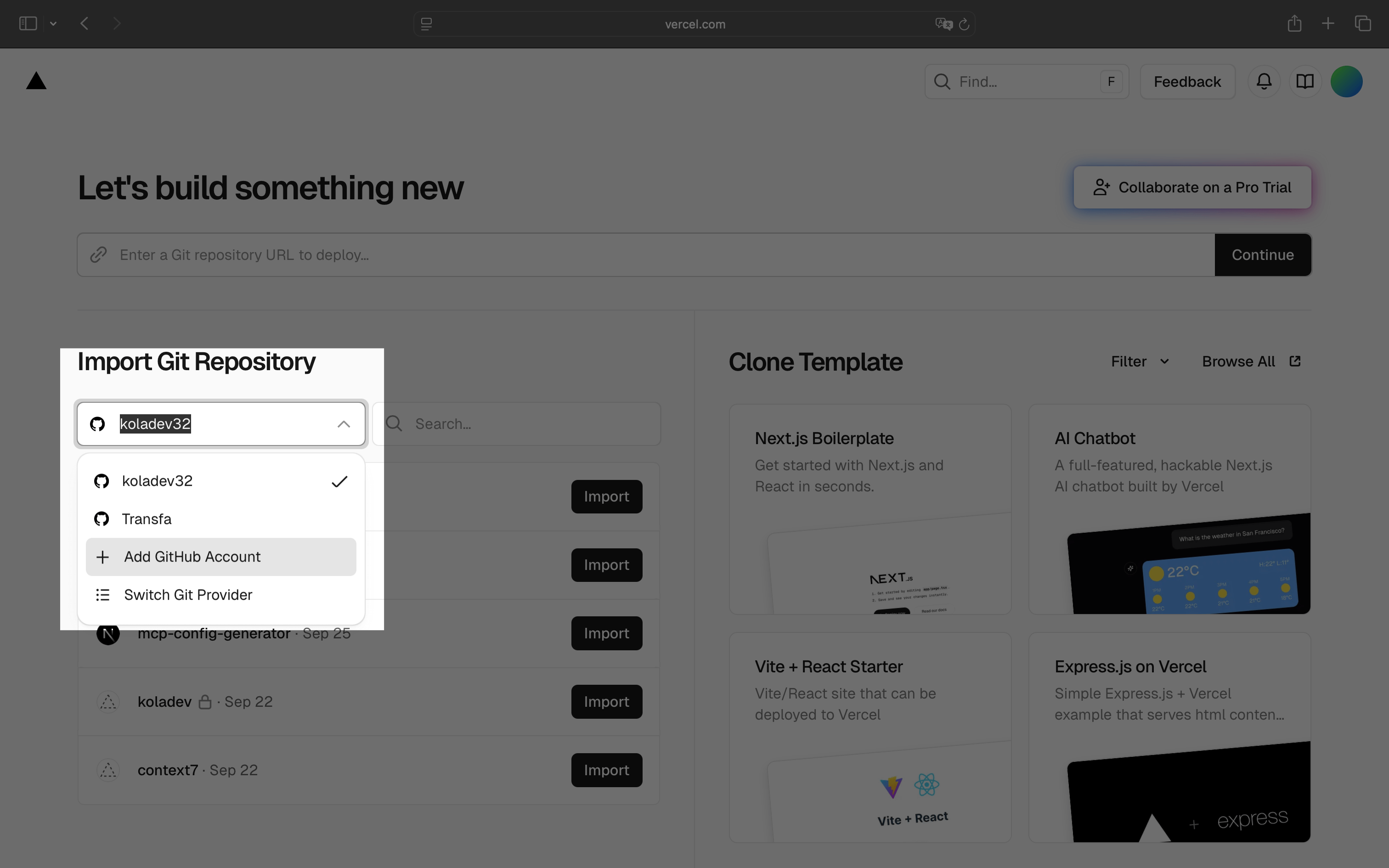
Vercel shows you a configuration page where you set the application name, build commands, and environment variables.
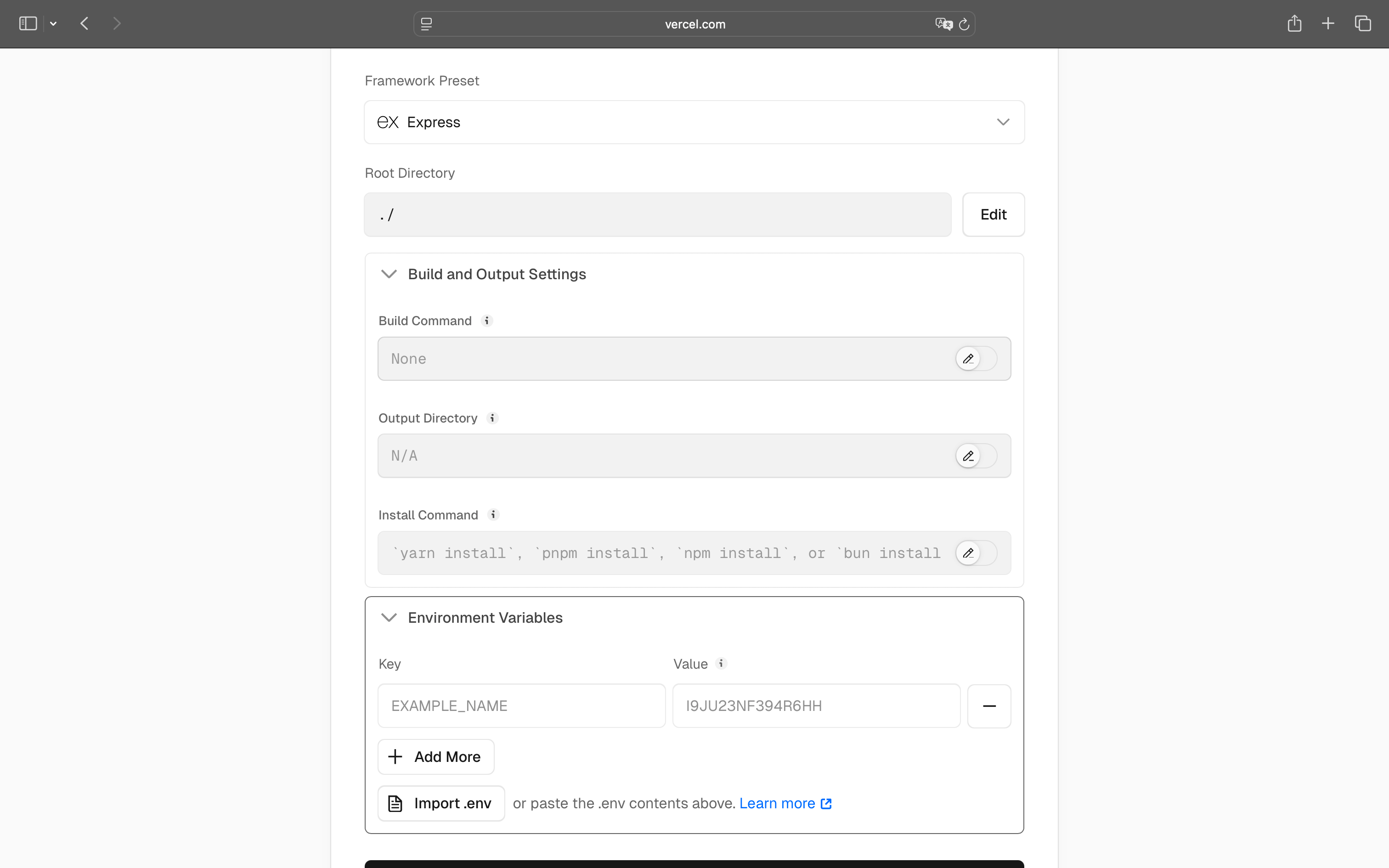
Since we're deploying an Express application, we set the Framework Preset to Express so Vercel knows how to handle the deployment.
After deployment, Vercel provides two URLs:
- The latest deployment URL which is updated with each commit if automatic deployment is enabled.
- The production domain where Vercel assigns a default
.vercel.appdomain.
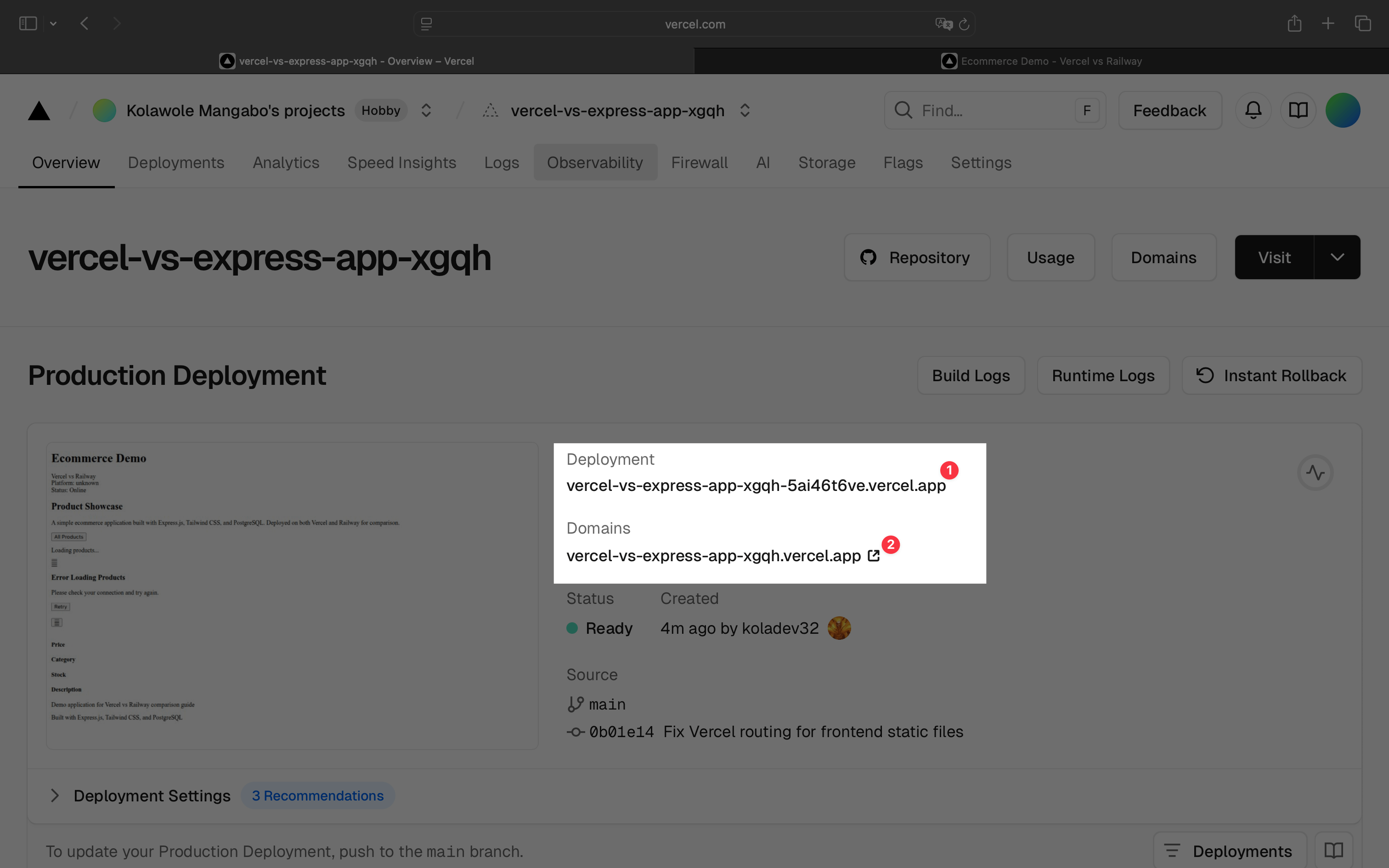
Adding the Database
Our Express app needs PostgreSQL, so we added a database through Vercel's Storage tab.
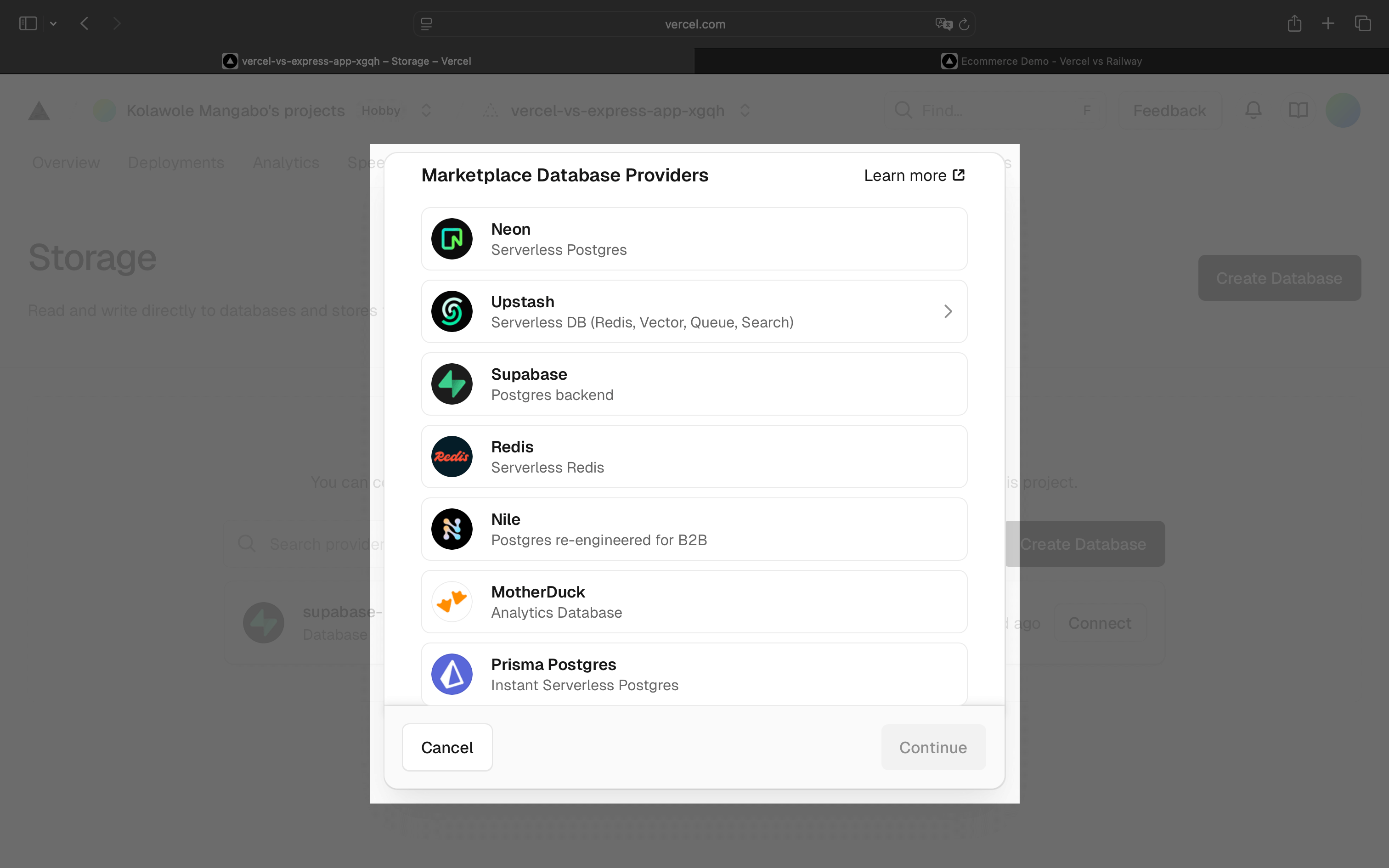
Vercel offers integrations with Supabase, Neon, and Prisma Postgres. We chose Supabase's free tier.
Vercel automatically injects the database connection variables into the application environment with no manual configuration needed.
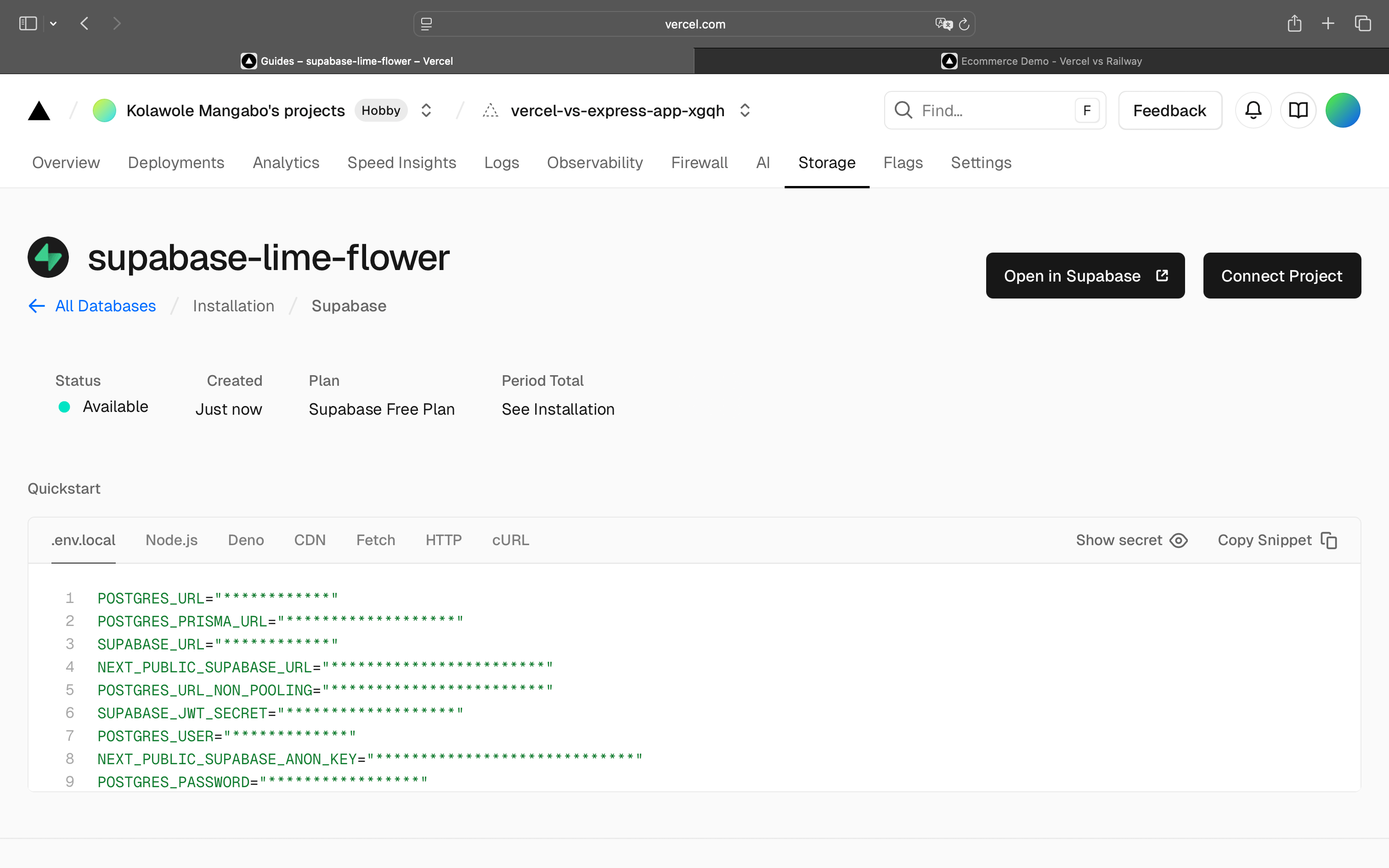
Configuring the Project
Vercel uses a vercel.json file for project configuration. Here's what we used to configure the Express server, routes, and static files:
{
"version": 2,
"builds": [
{
"src": "server.js",
"use": "@vercel/node"
}
],
"routes": [
{
"src": "/api/(.*)",
"dest": "/server.js"
},
{
"src": "/(.*\\.css|.*\\.js|.*\\.jpg|.*\\.png|.*\\.svg|.*\\.ico)",
"dest": "/public/$1"
},
{
"src": "/(.*)",
"dest": "/server.js"
}
]
}
The vercel.json file tells Vercel how to build and route your application. The builds array specifies that server.js should run as a Node.js serverless function using @vercel/node. The routes array maps incoming requests to either your Express server or static files in the public directory.
For our Express app, we needed it because Vercel doesn't automatically know how to route /api/* requests to our server file or where to find static assets.
Deploying on Railway
Railway's deployment is similar to Vercel's, but with key differences in project visualization and service connections.
Railway runs Docker containers, so you can deploy databases, workers, and multiple services, not just web applications.
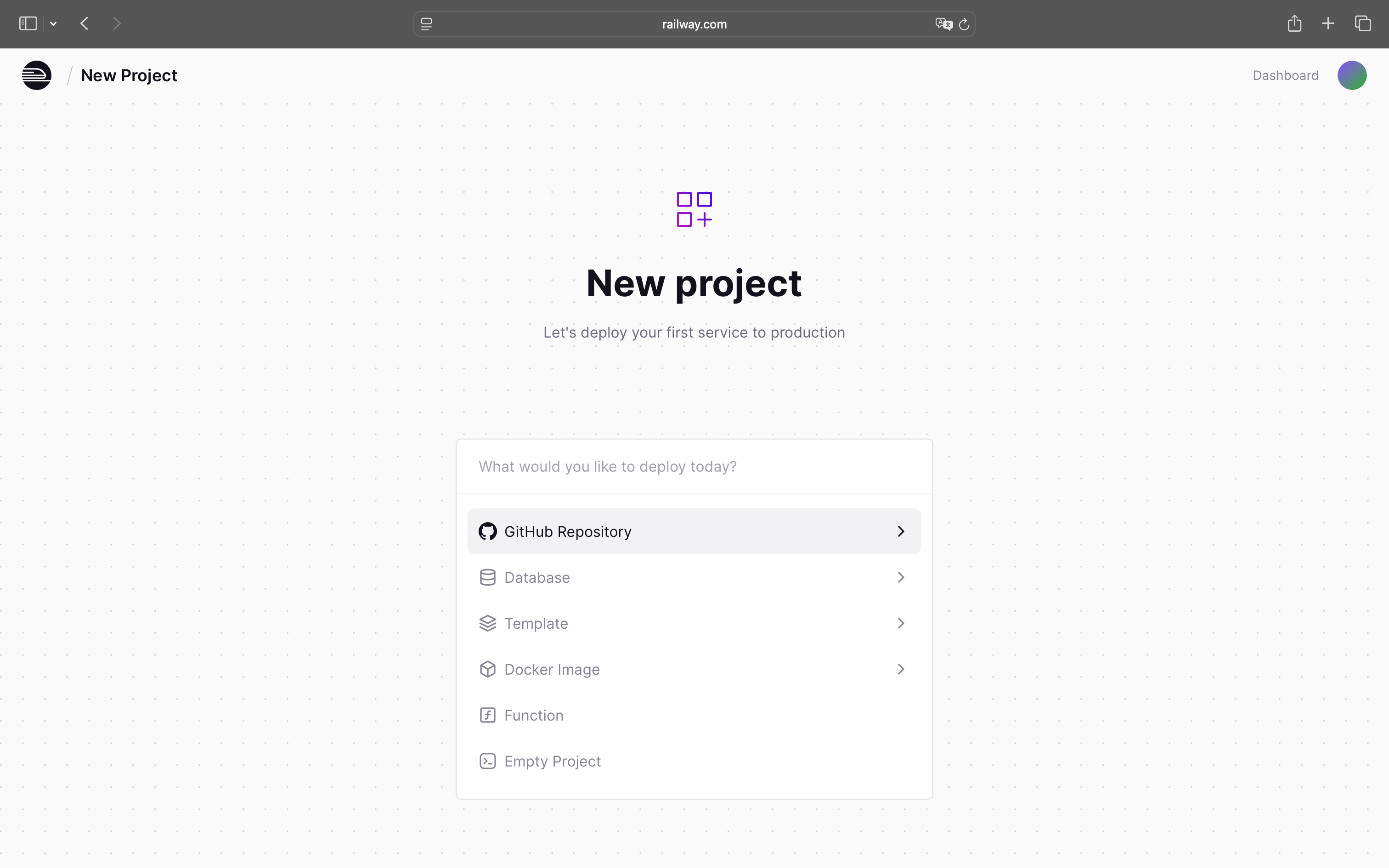
After importing your GitHub project, Railway builds and deploys using your Dockerfile. Here's the Dockerfile we used:
# Multi-stage build for optimized production image
FROM node:22-alpine AS builder
# Set working directory
WORKDIR /app
# Copy package files
COPY package*.json ./
# Install all dependencies (including dev dependencies for building)
RUN npm ci
# Copy source code
COPY . .
# Build Tailwind CSS
RUN npx tailwindcss -i ./public/css/input.css -o ./public/css/output.css
# Production stage
FROM node:18-alpine AS production
# Set working directory
WORKDIR /app
# Copy package files
COPY package*.json ./
# Install only production dependencies
RUN npm ci --only=production && npm cache clean --force
# Copy built application from builder stage
COPY --from=builder /app/server.js ./
COPY --from=builder /app/public ./public
# Create non-root user
RUN addgroup -g 1001 -S nodejs
RUN adduser -S nextjs -u 1001
# Change ownership of the app directory
RUN chown -R nextjs:nodejs /app
USER nextjs
# Expose port (Railway will use PORT env var)
# The actual port will be provided by Railway via PORT environment variable
EXPOSE ${PORT:-3000}
# Health check (use PORT env var or default to 3000)
HEALTHCHECK --interval=30s --timeout=3s --start-period=40s --retries=3 \
CMD node -e "require('http').get('http://localhost:' + (process.env.PORT || 3000) + '/api/health', (r) => {process.exit(r.statusCode === 200 ? 0 : 1)})"
# Start the application
CMD ["npm", "start"]
This multi-stage Dockerfile builds Tailwind CSS in the first stage, then copies only the production files to a smaller final image. The health check lets Railway verify the container is responding correctly.
The first build takes around 75 seconds – longer than Vercel's 15 seconds because Railway builds the full Docker container. After the initial build, Railway caches packages and layers to speed up subsequent deployments.
Adding the Database
Adding a database works like adding any service in Railway. Click "New" and select from PostgreSQL, MySQL, Redis, or MongoDB. We chose PostgreSQL, which deployed in 3 seconds.
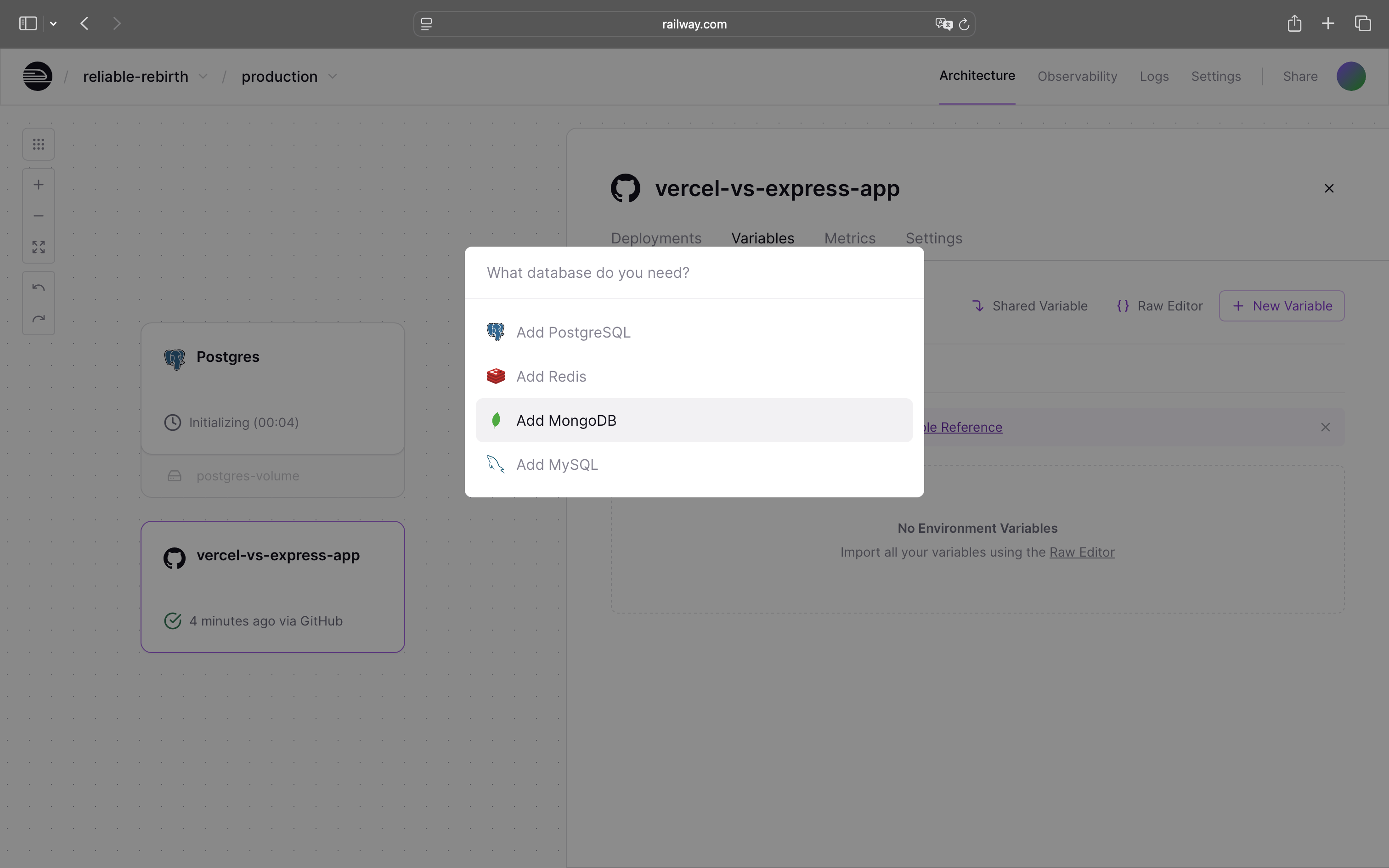
Once the database service is running, navigate to the Variables tab in your Express service. Railway prompts you to add database variables and lists all environment variables from the database service. We selected DATABASE_URL, which Railway automatically injects into the Express container, connecting both services over Railway's private network.
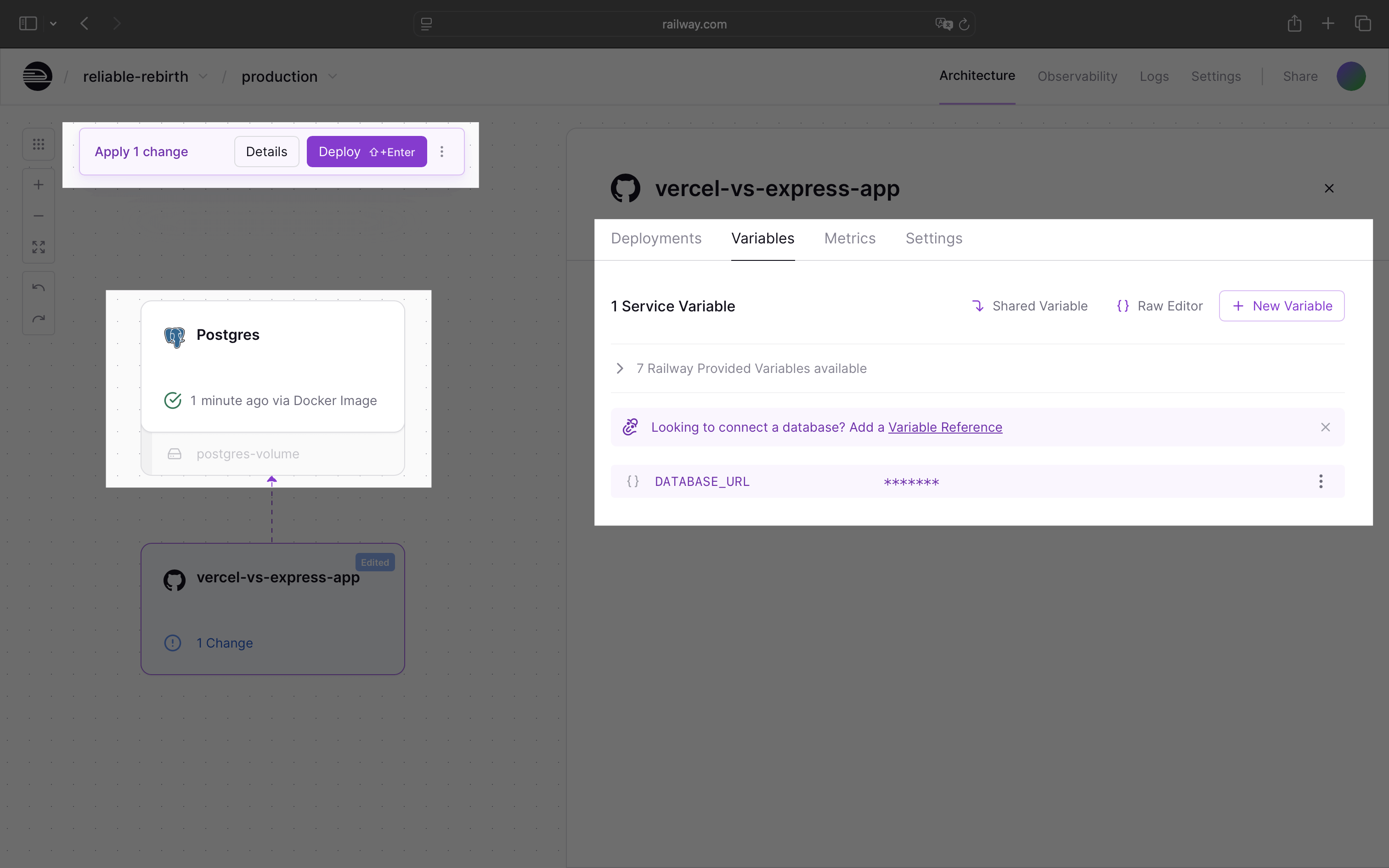
Get Your Application Link
To access your deployed application, navigate to Settings → Networking, then either generate a Railway-provided URL or add a custom domain.
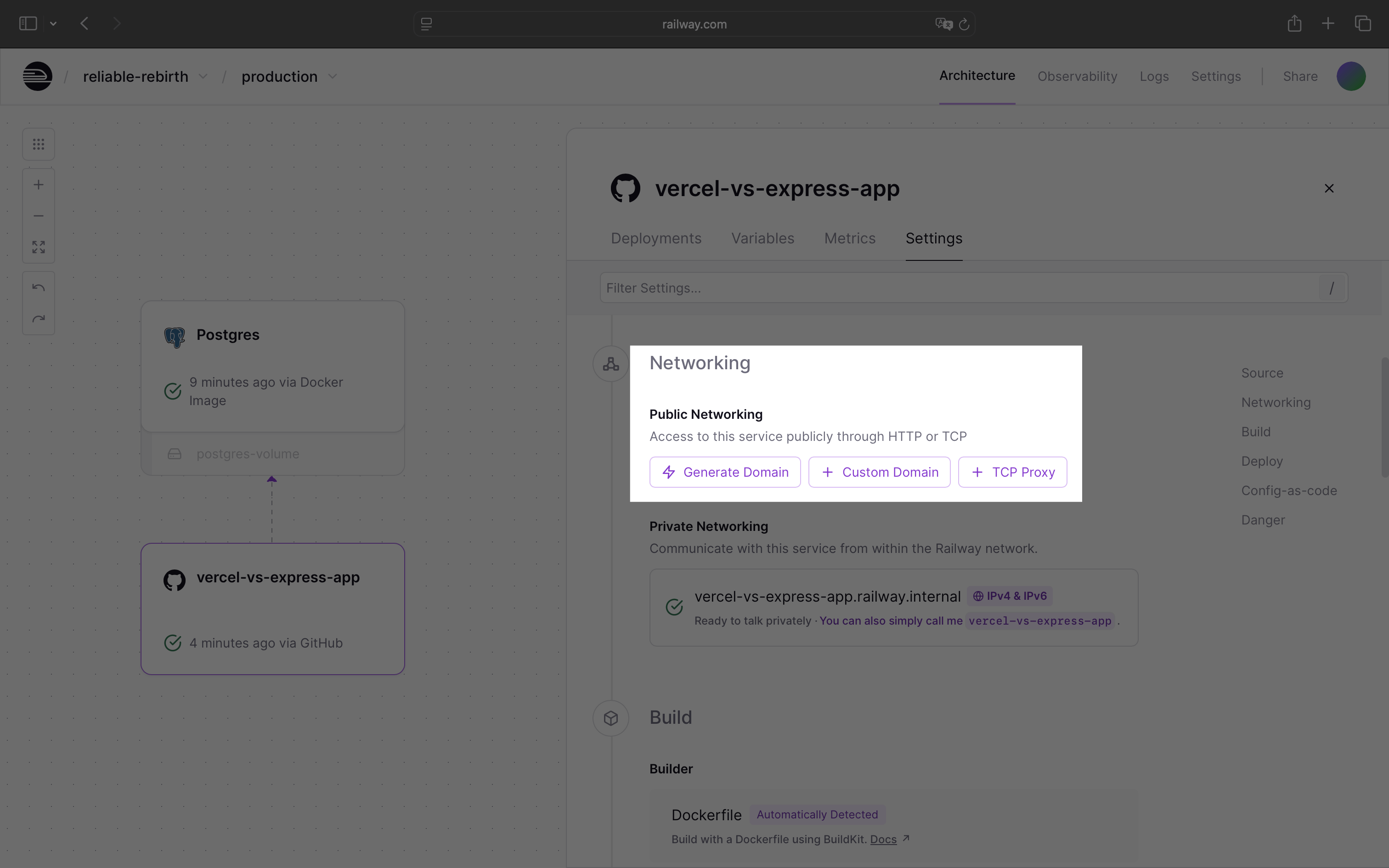
Deployment Challenges
Running migrations and seeding data on Vercel required retry logic we didn't need on Railway. Vercel's serverless functions occasionally timeout on the first database connection attempt, causing initialization to fail.
We added this retry mechanism with a 15-second timeout:
const initializeDatabase = async (retries = 3) => {
for (let attempt = 1; attempt <= retries; attempt++) {
try {
// Create table with 15-second timeout
await Promise.race([
pool.query(`
CREATE TABLE IF NOT EXISTS products (
id SERIAL PRIMARY KEY,
name VARCHAR(255) NOT NULL,
price DECIMAL(10,2) NOT NULL,
-- additional columns...
)
`),
new Promise((_, reject) =>
setTimeout(() => reject(new Error('Timeout')), 15000)
)
]);
// Insert sample data if table is empty
const result = await pool.query('SELECT COUNT(*) FROM products');
if (parseInt(result.rows[0].count) === 0) {
// Insert 5 sample products...
await pool.query('INSERT INTO products (...) VALUES ($1, $2, $3)', [...]);
}
return; // Success - exit retry loop
} catch (error) {
if (attempt < retries) {
await new Promise(resolve => setTimeout(resolve, 2000)); // Wait 2s
} else {
console.warn('Database init failed after all retries');
}
}
}
};
Without this retry logic, the first serverless function invocation fails because the database connection doesn't establish fast enough. Subsequent requests succeed once the connection pool warms up, but initial deployments require this workaround.
Railway didn't need this code; the persistent container maintains the database connection from startup, so initialization runs reliably on the first attempt.
Vercel: SSL Certificate Issues with Supabase
Connecting to Supabase's free tier from Vercel threw SSL verification errors because Supabase uses self-signed certificates. We had to disable SSL verification in the connection string:
const pool = new Pool({
connectionString: process.env.DATABASE_URL,
ssl: {
rejectUnauthorized: false // Required for Supabase free tier
}
});
Railway connected to the same Supabase instance without SSL configuration changes. This isn't a major blocker – the fix takes one Google search or an AI assistant prompt if you have one – but it's an extra step Vercel requires that Railway doesn't.
Our Takeaway
In summary, both platforms deployed the application successfully, but Vercel required platform-specific workarounds for database connections, whereas Railway handled them without modification. If you're new to serverless architectures, these quirks add friction that isn't immediately obvious from the documentation.
Monitoring and Observability
Both platforms provide built-in monitoring, but Vercel offers more granular observability tools.
Railway's Monitoring
Railway's dashboard shows real-time metrics for your services:
- CPU and memory usage.
- Network traffic and disk usage.
- Error rates by service.
- Deployment history.
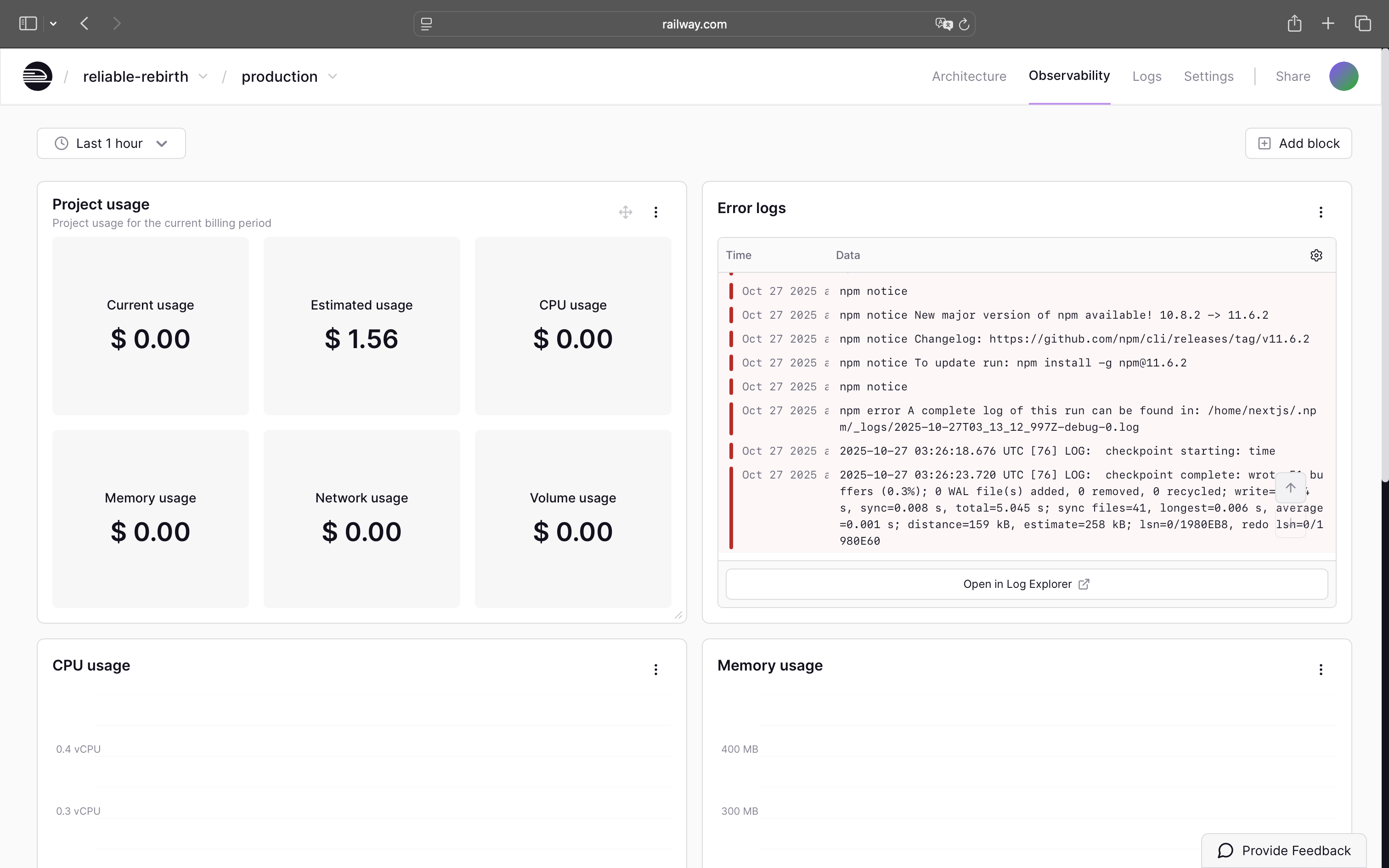
The Logs page live-tails your application output with a search and filtering text input. Log retention is 7 days on Hobby, 30 days on Pro, and 90 days on Enterprise.
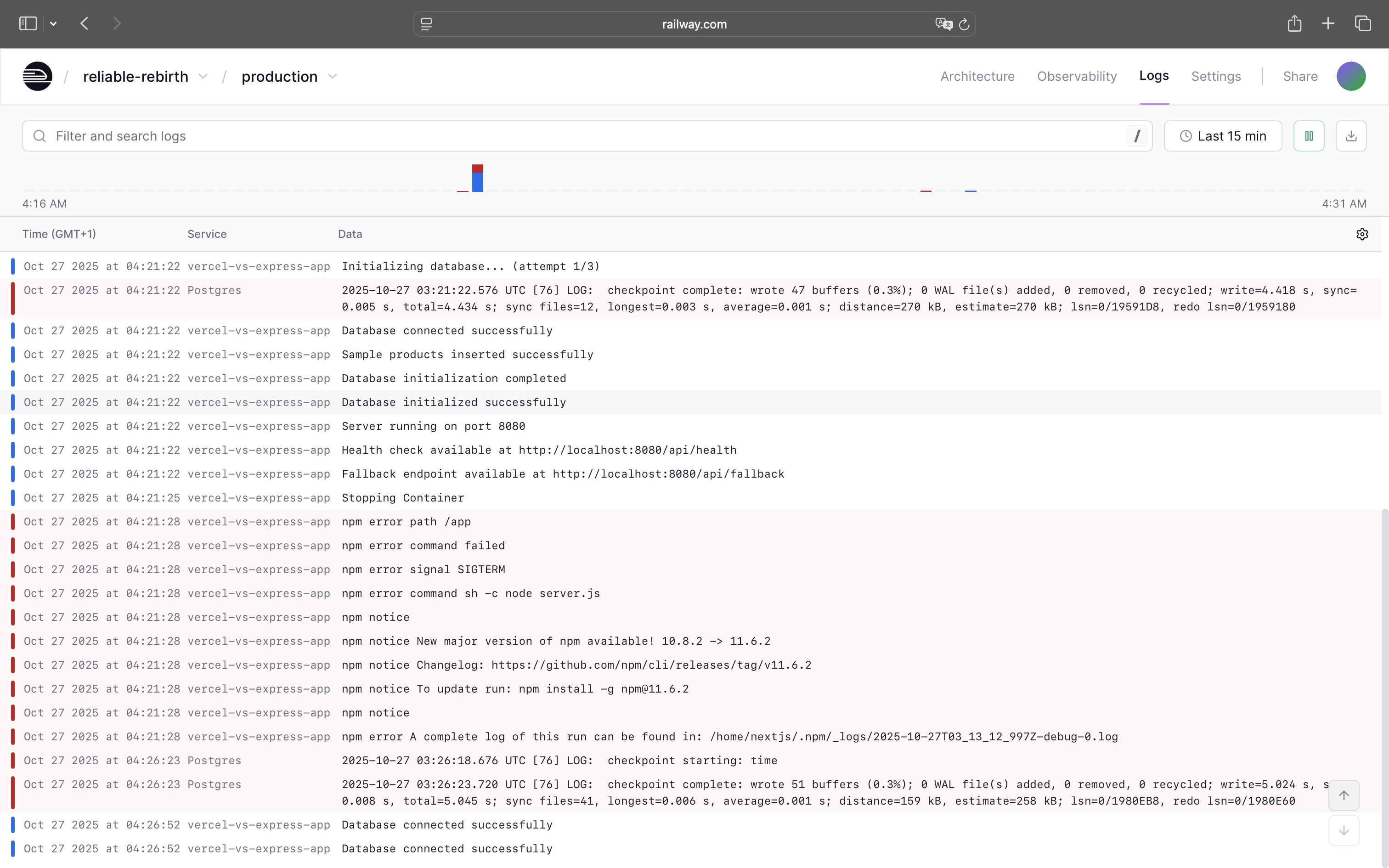
Railway's dashboards give you enough information to spot resource bottlenecks and catch errors, but don't provide request-level tracing or performance breakdowns.
Vercel's Monitoring
Vercel's Logs page offers more filtering options:
- Filter by log type, such as warnings, errors, or fatal.
- Filter by environment, like production, preview, or development.
- Live-tail or search historical logs.
- Filter by specific function or route.
- Filter by resource, host, request type, and request path.
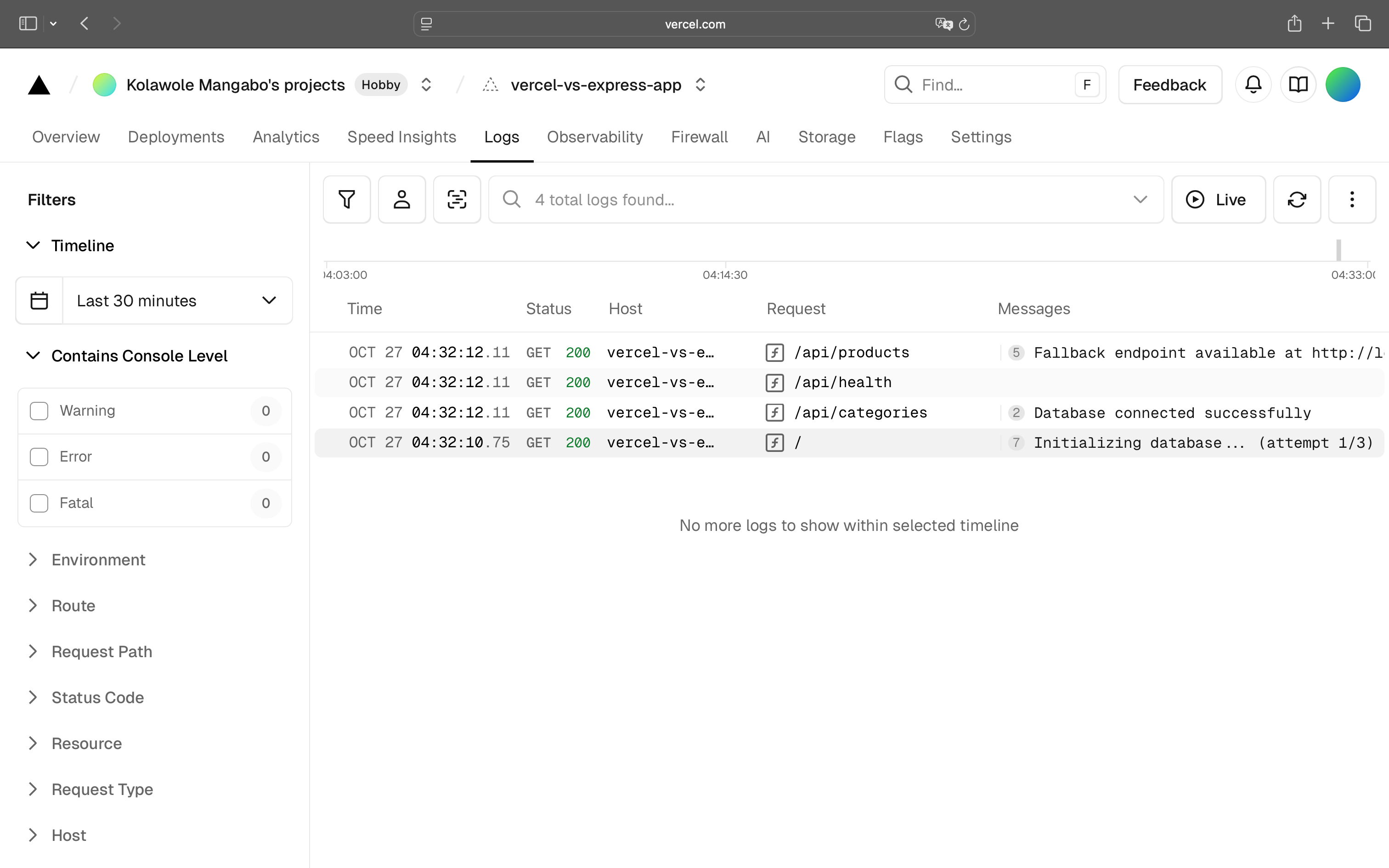
The Observability page adds deeper insights:
-
Query performance and slow endpoints.
-
Middleware execution time.
-
Request duration and cold start metrics.
-
Build diagnostics and deployment health.
-
Custom alerts for errors or performance thresholds.
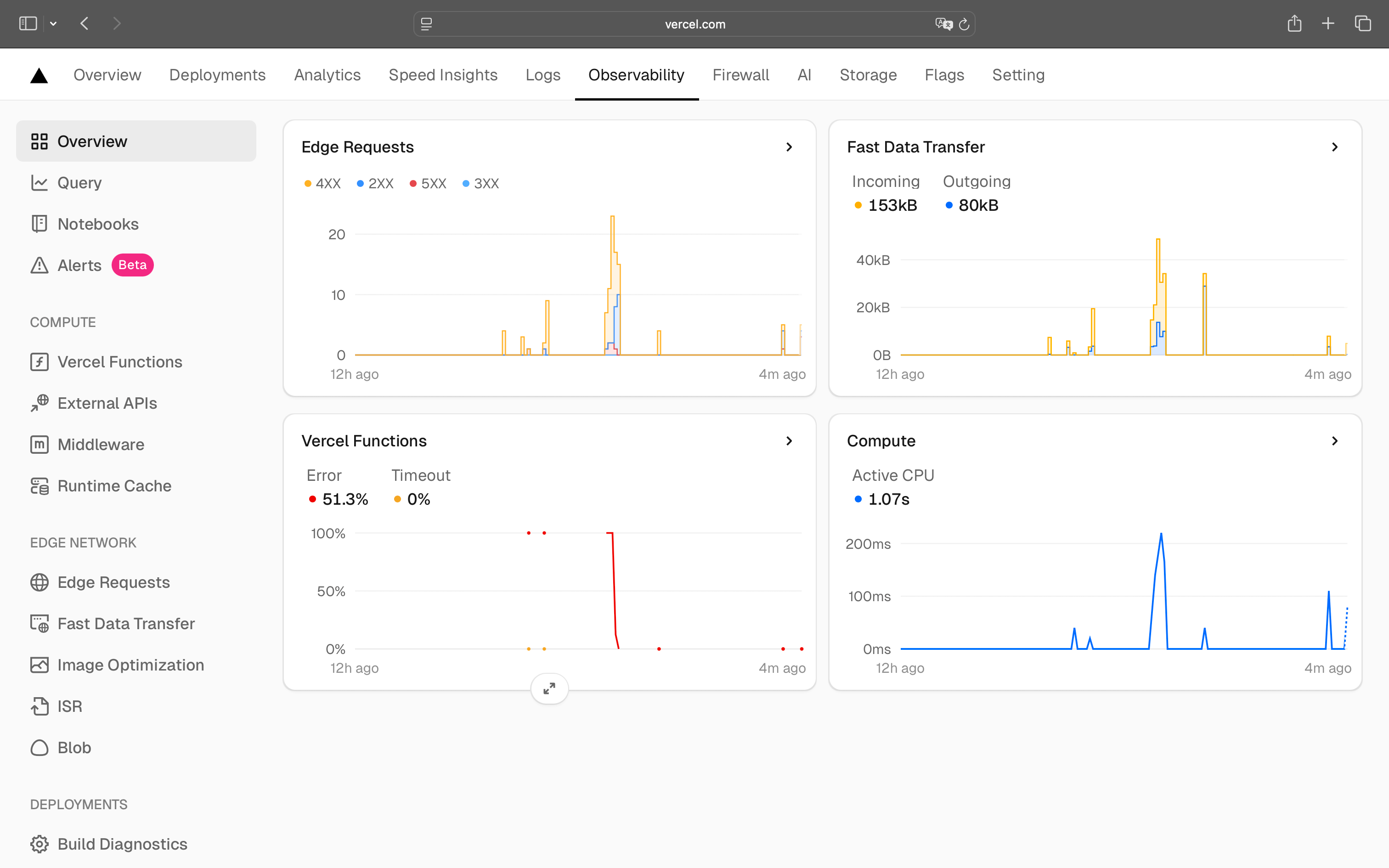
Vercel's observability helps you diagnose performance issues at the request level, identifying which API routes are slow, where cold starts impact users, and how middleware affects response times.
Our Takeaway
We found Vercel's observability tools more useful for debugging performance issues. The request-level data, response times, function execution duration, and cold start metrics provide enough metrics to tell if an endpoint is slow or not.
Railway's dashboards focus on infrastructure metrics, CPU, memory, and error counts. It can help to spot resource bottlenecks and catch crashes, but it can't help drill down into which specific endpoints caused problems.
Pricing
Both platforms justify their pricing differently: Vercel charges for abstraction and convenience, while Railway charges for raw compute resources.
Vercel's Pricing: Paying for Abstraction
Vercel bundles infrastructure management into the cost. You're not just paying for compute but you're paying for zero server configuration, automatic scaling, global CDN, image optimization, and built-in analytics. The Pro plan starts at $20/user/month with usage overages for bandwidth ($0.15/GB) and edge requests ($2 per million).
We found Vercel's pricing makes sense for frontend-heavy apps with moderate API usage. The convenience of having everything configured automatically justifies the premium, especially if your team doesn't want to manage infrastructure.
Railway's Pricing: Paying for Resources
Railway charges directly for what you consume–CPU time ($0.000463/vCPU-minute), memory ($0.000231/GB-minute), and bandwidth ($0.10/GB). The Hobby plan includes $5 of usage credits monthly for $5/month. Pro includes $20 credits for $20/month.
We found Railway cheaper for backend-heavy workloads because you're not paying for bundled features you don't need. An Express API with Postgres serving thousands of requests per month that sits at 20% CPU utilization costs roughly $10-15/month on Railway versus $50-100/month on Vercel once you factor in bandwidth and request charges when you have spikes.
Vendor Lock-In
Migration difficulty varies significantly between platforms. Railway's Docker-based approach makes moving to other platforms straightforward, while Vercel's serverless model creates platform-specific dependencies.
Vercel's Lock-in: Moderate to High
Vercel's serverless architecture requires platform-specific code patterns that don't translate to other platforms. A startup migrating their e-commerce platform from Vercel to Railway required three weeks and rebuilding their entire checkout. The catalyst? A $2,000 monthly bandwidth bill from processing 50,000 orders that was killing their margins.
Code written for Vercel's serverless functions uses platform-specific patterns:
- Vercel-specific API routes and exports.
- Edge function implementations that don't translate elsewhere.
- ISR, Image Optimization, and other Vercel-native features.
- Environment variable handling is tied to Vercel's deployment model.
Railway's Lock-in: Minimal
Railway uses standard Docker containers. Your Express application runs identically on Railway, AWS, Google Cloud, or any container platform. Your Dockerfile and application code move without modification. Railway-specific features like service linking translate easily to standard container orchestration tools like Kubernetes or Docker Compose.
Here are some interesting migrations scenarios:
- Vercel → Railway: 1-4 weeks for a medium application or more. It will refactor serverless functions into Express routes, replacing Vercel APIs, and rearchitecting platform-specific features.
- Railway → Vercel: Extremely difficult or impossible if you use WebSockets, background workers, or long-running tasks. This will require fundamental rearchitecture with external services.
- Railway → Any Container Platform: It will take days. You need to export your Dockerfile, update the environment variables, and redeploy. It works perfectly on AWS ECS, Google Cloud Run, Azure, DigitalOcean, Fly.io, or your own servers.
The Next.js Factor
Vercel created Next.js, and while it's open source, certain features work best (or only) on Vercel's infrastructure. ISR (Incremental Static Regeneration), Edge Runtime, and Image Optimization are tightly coupled to Vercel's platform.
Deploying Next.js to other platforms often means losing these features or implementing workarounds. This isn't accidental lock-in, but it does mean choosing Vercel and Next.js together creates a stronger platform dependency than using Express on either platform.
Our Takeaway
We found Railway's portability valuable even if we never migrate. Knowing we can move to another platform without rebuilding the application removes a major business risk. With Vercel, every platform-specific feature we add – Edge Functions, ISR, Image Optimization – increases the cost of leaving later.
The real cost of vendor lock-in isn't necessarily the monthly subscription: it's the weeks of engineering time and potential downtime when your requirements change and you need to migrate to another vendor.
Developer Experience
Both platforms prioritize developer experience, but they optimize for different workflows: Vercel for speed and zero configuration, Railway for control and flexibility.
Vercel
Deployment Speed and Workflow
Vercel optimizes for frontend deployment speed. Build times run 30 seconds to 3 minutes, thanks to aggressive caching. You connect your GitHub repository and Vercel detects your framework, configures build settings, and deploys automatically.
Every git push triggers a new deployment, and merged pull requests ship to production without manual intervention.
CLI Tools and Local Development
Vercel CLI handles deployment, environment variables, and log inspection. The CLI focuses primarily on deployment rather than local development. You use your framework's dev server (like next dev) for local work. Vercel-specific features sometimes behave differently locally versus in production, particularly around serverless function execution and timeouts.
Configuration and Infrastructure as Code
Vercel uses vercel.json for route and build configuration, but most settings live in the dashboard. Moving configuration between projects or teams requires manual UI work.
The serverless model abstracts infrastructure decisions, simplifying initial setup but limiting customization when you need deeper control.
Railway
Deployment Speed and Workflow
Railway matches Vercel's deployment simplicity with added flexibility. Builds complete in 1-4 minutes, depending on dependencies.
Railway's Railpack automatically detects your stack and generates a build configuration. You choose between automatic deployments on every push or manual deployment triggers, giving you control over when code ships to production.
CLI Tools and Local Development
Railway CLI extends beyond deployment into local development workflows. The railway run command executes code with production environment variables loaded locally, and railway link connects your local project to Railway services like databases. This bridges the local-to-production gap more effectively than Vercel's approach.
Configuration and Infrastructure as Code
Railway uses railway.json or railway.toml for configuration, with full support for managing everything as code. Dockerfile support provides complete control over your build and runtime environment. Version control your entire infrastructure setup alongside your application code.
Our Takeaway
We found Vercel's zero-config approach to be the fastest for frontend projects where infrastructure shouldn't be a concern. Railway's flexibility with Dockerfiles and railway run gave us better local-to-production parity, which mattered more for our Express backend, where debugging environment-specific issues was critical.
Final Thoughts
After deploying the same Express + Postgres application to both platforms, we found Railway's container model works better for most Express applications, with lower costs ($15-25/month vs $50-100/month), no architectural constraints around WebSockets or background jobs, and easy migration to other platforms if you outgrow it.
Vercel makes sense when you're all-in on Next.js and want infrastructure to disappear completely, or when unpredictable traffic spikes justify paying for automatic scaling.
At the end of the day, it depends on your type of project:
- If you have a full-stack project relying heavily on the backend not only for retrieving data, but also for processing tasks, handling asynchronous work, or maintaining persistent connections, choose Railway.
- If you're building a frontend-focused application with simple API routes that complete quickly, choose Vercel.